Abstract
While struggling to map the ‘post-modern condition’, social theorists have increasingly discovered space, not as an innocent background, but as ‘an active constituent component of hegemonic power — the medium and the message of domination and subordination’.1 Social and cultural life is now shaped, it is argued, by the logic of spatial organisation rather than time and to the fluidity of spatial is contrasted identities entailed in this process is contrasted the fixity of ‘pre-modern’ identities, typically founded on religion.2
Access this chapter
Tax calculation will be finalised at checkout
Purchases are for personal use only
Preview
Unable to display preview. Download preview PDF.
Notes
Place and the Politics of Identity, M. Keith and S. Pile (eds), (London, 1993).
E.W. McFarland, Protestants First: Orangeism in Nineteenth Century Scotland (Edinburgh, 1990), pp. 70–91.
M.W. Dewar, Orangeism: a New Historical Appreciation (Belfast, 1973), p. 83.
S. A. Marston, ‘Public Rituals and Community Power: St Patrick’s Day Parades in Lowell, Massachusetts, 1841–74, Political Geography Quarterly, 8/3, July 1989, pp. 255–69;
S.G. Dawes, Parades and Power: Street Theatre in Nineteenth Century Philadelphia (Phildelphia), 1986.
G. Walker, ‘The Protestant Irish in Scotland’, in Irish Immigrants in Scottish Society, ed. T. Devine (Edinburgh), 1990, p. 49.
A.B. Campbell, The Lanarkshire Miners (Edinburgh), 1974, p. 183.
R.D. Lobban, ‘The Irish Community in Greenock in the Nineteenth Century’, Irish Geography, VI, 1972, pp. 270–81.
See S. Smith, ‘Bounding the Borders: Claiming Space and Making Place in Rural Scotland’, Transactions of the Institute of British Geographers, 18, 3, 1993, pp. 292.
J. Bradley, Ethnic and Religious Identity in Modern Scotland (Aldershot, 1995) p. 97.
Editor information
Editors and Affiliations
Copyright information
© 2000 Palgrave Macmillan, a division of Macmillan Publishers Limited
About this chapter
Cite this chapter
McFarland, E. (2000). Marching from the Margins: Twelfth July Parades in Scotland, 1820–1914. In: Fraser, T.G. (eds) The Irish Parading Tradition. Ethnic and Intercommunity Conflict Series. Palgrave Macmillan, London. https://doi.org/10.1057/9780333993859_5
Download citation
DOI: https://doi.org/10.1057/9780333993859_5
Publisher Name: Palgrave Macmillan, London
Print ISBN: 978-0-333-91836-4
Online ISBN: 978-0-333-99385-9
eBook Packages: Palgrave Political & Intern. Studies CollectionPolitical Science and International Studies (R0)

